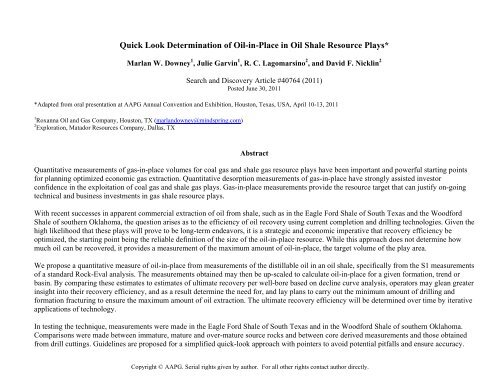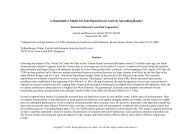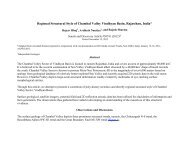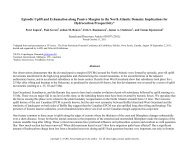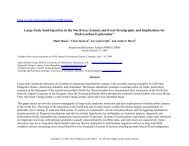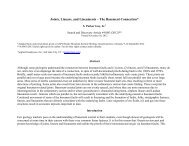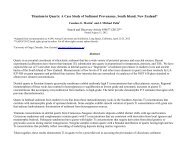Quick Look Determination of Oil-in-Place in Oil Shale Resource ...
Quick Look Determination of Oil-in-Place in Oil Shale Resource ...
Quick Look Determination of Oil-in-Place in Oil Shale Resource ...
You also want an ePaper? Increase the reach of your titles
YUMPU automatically turns print PDFs into web optimized ePapers that Google loves.
<strong>Quick</strong> <strong>Look</strong> <strong>Determ<strong>in</strong>ation</strong> <strong>of</strong> <strong>Oil</strong>-<strong>in</strong>-<strong>Place</strong> <strong>in</strong> <strong>Oil</strong> <strong>Shale</strong> <strong>Resource</strong> Plays*<br />
Marlan W. Downey 1 , Julie Garv<strong>in</strong> 1 , R. C. Lagomars<strong>in</strong>o 2 , and David F. Nickl<strong>in</strong> 2<br />
Search and Discovery Article #40764 (2011)<br />
Posted June 30, 2011<br />
*Adapted from oral presentation at AAPG Annual Convention and Exhibition, Houston, Texas, USA, April 10-13, 2011<br />
1 Roxanna <strong>Oil</strong> and Gas Company, Houston, TX (marlandowney@m<strong>in</strong>dspr<strong>in</strong>g.com)<br />
2 Exploration, Matador <strong>Resource</strong>s Company, Dallas, TX<br />
Abstract<br />
Quantitative measurements <strong>of</strong> gas-<strong>in</strong>-place volumes for coal gas and shale gas resource plays have been important and powerful start<strong>in</strong>g po<strong>in</strong>ts<br />
for plann<strong>in</strong>g optimized economic gas extraction. Quantitative desorption measurements <strong>of</strong> gas-<strong>in</strong>-place have strongly assisted <strong>in</strong>vestor<br />
confidence <strong>in</strong> the exploitation <strong>of</strong> coal gas and shale gas plays. Gas-<strong>in</strong>-place measurements provide the resource target that can justify on-go<strong>in</strong>g<br />
technical and bus<strong>in</strong>ess <strong>in</strong>vestments <strong>in</strong> gas shale resource plays.<br />
With recent successes <strong>in</strong> apparent commercial extraction <strong>of</strong> oil from shale, such as <strong>in</strong> the Eagle Ford <strong>Shale</strong> <strong>of</strong> South Texas and the Woodford<br />
<strong>Shale</strong> <strong>of</strong> southern Oklahoma, the question arises as to the efficiency <strong>of</strong> oil recovery us<strong>in</strong>g current completion and drill<strong>in</strong>g technologies. Given the<br />
high likelihood that these plays will prove to be long-term endeavors, it is a strategic and economic imperative that recovery efficiency be<br />
optimized, the start<strong>in</strong>g po<strong>in</strong>t be<strong>in</strong>g the reliable def<strong>in</strong>ition <strong>of</strong> the size <strong>of</strong> the oil-<strong>in</strong>-place resource. While this approach does not determ<strong>in</strong>e how<br />
much oil can be recovered, it provides a measurement <strong>of</strong> the maximum amount <strong>of</strong> oil-<strong>in</strong>-place, the target volume <strong>of</strong> the play area.<br />
We propose a quantitative measure <strong>of</strong> oil-<strong>in</strong>-place from measurements <strong>of</strong> the distillable oil <strong>in</strong> an oil shale, specifically from the S1 measurements<br />
<strong>of</strong> a standard Rock-Eval analysis. The measurements obta<strong>in</strong>ed may then be up-scaled to calculate oil-<strong>in</strong>-place for a given formation, trend or<br />
bas<strong>in</strong>. By compar<strong>in</strong>g these estimates to estimates <strong>of</strong> ultimate recovery per well-bore based on decl<strong>in</strong>e curve analysis, operators may glean greater<br />
<strong>in</strong>sight <strong>in</strong>to their recovery efficiency, and as a result determ<strong>in</strong>e the need for, and lay plans to carry out the m<strong>in</strong>imum amount <strong>of</strong> drill<strong>in</strong>g and<br />
formation fractur<strong>in</strong>g to ensure the maximum amount <strong>of</strong> oil extraction. The ultimate recovery efficiency will be determ<strong>in</strong>ed over time by iterative<br />
applications <strong>of</strong> technology.<br />
In test<strong>in</strong>g the technique, measurements were made <strong>in</strong> the Eagle Ford <strong>Shale</strong> <strong>of</strong> South Texas and <strong>in</strong> the Woodford <strong>Shale</strong> <strong>of</strong> southern Oklahoma.<br />
Comparisons were made between immature, mature and over-mature source rocks and between core derived measurements and those obta<strong>in</strong>ed<br />
from drill cutt<strong>in</strong>gs. Guidel<strong>in</strong>es are proposed for a simplified quick-look approach with po<strong>in</strong>ters to avoid potential pitfalls and ensure accuracy.<br />
Copyright © AAPG. Serial rights given by author. For all other rights contact author directly.
A QUICKLOOK DETERMINATION OF<br />
OIL-IN-PLACE IN OIL SHALE<br />
RESOURCE PLAYS<br />
Marlan W. Downey, Julie Garv<strong>in</strong>, RC Lagomars<strong>in</strong>o, David F.<br />
Nickl<strong>in</strong>
ACKNOWLEDGEMENTS:<br />
<br />
<br />
<br />
<br />
<br />
<br />
Roxanna <strong>Oil</strong> and Gas Company<br />
Eddie Little<br />
Matador <strong>Resource</strong>s Company<br />
Anne L<strong>in</strong>dsey McColloch<br />
Just<strong>in</strong> Bagley<br />
Bo Henk
DISCUSSION TOPICS<br />
Gas-<strong>in</strong>-place measurements <strong>in</strong> the Coal and<br />
<strong>Shale</strong> Gas Industry<br />
<br />
Gas desorption methodology<br />
Importance <strong>of</strong> Hydrocarbon Target Volumes<br />
<strong>in</strong> Unconventional <strong>Resource</strong> Plays<br />
Measure amount <strong>of</strong> Hydrocarbons available<br />
Application <strong>of</strong> RockEval Pyrolysis for S1 values
GAS DESORPTION METHODOLOGY<br />
Standard analytical technique over 20 years<br />
Measures total gas conta<strong>in</strong>ed <strong>in</strong> coal cores or<br />
shale cores.<br />
Allows the determ<strong>in</strong>ation <strong>of</strong> the total gas<br />
resource <strong>in</strong> place <strong>in</strong> a given area.
HYDROCARBON TARGET VOLUMES<br />
Focus on application <strong>of</strong> hydrocarbon<br />
distillation from Rock-Eval.<br />
Requires rock samples, preferably whole core,<br />
properly collected.<br />
Determ<strong>in</strong>es volumes <strong>of</strong> distillable hydrocarbons<br />
<strong>in</strong> the rock <strong>in</strong> mg <strong>of</strong> hydrocarbon/g <strong>of</strong> dry rock.<br />
Relatively simple and cheap to do.<br />
Results can be obta<strong>in</strong>ed early <strong>in</strong> exploration<br />
campaign.<br />
Easily up-scaled to reflect total rock potential.
HYDROCARBON TARGET VOLUMES<br />
Emphasis on S1 measurement<br />
<strong>of</strong> distillable hydrocarbons.
Rock Eval Pyrolysis<br />
S1 represents the free hydrocarbons <strong>in</strong> a rock<br />
• Primarily <strong>in</strong>dicates generated free oil (liquid hydrocarbons)<br />
• The greater the S1 value, the greater amount <strong>of</strong> free oil<br />
• Optimum data from whole core<br />
S1 Peak<br />
Volatilization <strong>of</strong><br />
exist<strong>in</strong>g HC<br />
Exist<strong>in</strong>g <strong>Oil</strong><br />
Tmax<br />
S2 Peak<br />
Pyrolysis <strong>of</strong> kerogen<br />
(nonvolatile organic matter)<br />
Potential <strong>Oil</strong><br />
TEMPERATURE<br />
TIME
APPLICATION PROCEDURE<br />
Establish S1 values, preferably from whole core,<br />
preferably every foot. This represents measured oil<strong>in</strong>-place<br />
per unit volume <strong>of</strong> rock.<br />
Upscale oil-<strong>in</strong>-place to Acre-feet or “Section-feet”<br />
(i.e. one square mile <strong>of</strong> surface area x one foot thick<br />
x hydrocarbon richness).<br />
Result<strong>in</strong>g volume from core measurements is a<br />
m<strong>in</strong>imum value for the oil-<strong>in</strong>-place volume.
METHODOLOGY: OIL IN PLACE FROM S1<br />
Step 1: grams <strong>of</strong> oil per section<br />
M S1HC = Ah (ρ Av ) (S1 Av )(.001) ÷ 8.11E-10 acre-ft/cc<br />
Where:<br />
M S1HC = Mass <strong>of</strong> S1 hydrocarbons per section (g)<br />
A = Area <strong>of</strong> <strong>in</strong>terest <strong>in</strong> acres (sectional area – 640 acres)<br />
h = Reservoir height (ft)<br />
ρ Av = Average bulk density (g/cc)<br />
S1 Av =Average S1 (mg/g)
METHODOLOGY (CONT.)<br />
Step 2: volume <strong>of</strong> oil per section (cc)<br />
V S1HC = M S1HC ÷ρ oil<br />
Where:<br />
V S1HC = Volume <strong>of</strong> S1 hydrocarbons per section (cc)<br />
M S1HC = Mass <strong>of</strong> S1 hydrocarbons per section (g)<br />
ρ oil = Density <strong>of</strong> oil (g/cc)
METHODOLOGY (CONT.)<br />
Step 3: barrels <strong>of</strong> oil per section<br />
<strong>Oil</strong> <strong>in</strong> <strong>Place</strong> per section (Bbl)<br />
=<br />
V S1HC x 6.29E-6 bbl/cc
OIL IN PLACE FROM S1<br />
Simplified Equation<br />
<strong>Oil</strong> <strong>in</strong> <strong>Place</strong> per 640 acre/ft = 4965.36 x (ρ Av ) (S1 Av )(ρ oil )<br />
Where:<br />
ρ Av = Average bulk density (g/cc)<br />
S1 Av =Average S1 (mg/g)<br />
ρ oil = Density <strong>of</strong> oil (g/cc)
OIL IN PLACE FROM S1<br />
Simplified Equation<br />
<strong>Oil</strong> <strong>in</strong> <strong>Place</strong> per 640 acre/ft = 9677.48 x (S1 Av )<br />
Where:<br />
S1 Av =Average S1 (mg/g)<br />
Assumes:<br />
2.5 g/cc Bulk Density<br />
50º API <strong>Oil</strong> Gravity
CONVERSIONS<br />
1 section = 640 Acres<br />
1 cc = 8.10713194 E-10 Acre-ft<br />
1 cc = 6.28981077E-6 Bbl<br />
Specific gravity = 141.5/(131.5 + API gravity)<br />
Specific gravity 1 =1 g/cc<br />
1 mg = .001 g
QUICKLOOK CONVERSION OF S1 TO OIL<br />
Us<strong>in</strong>g S1 <strong>in</strong> mg/g to BBL <strong>of</strong> <strong>Oil</strong> <strong>in</strong> 640 acres/foot<br />
72,000<br />
4.0<br />
56,000<br />
S1<br />
MG/G<br />
3.0<br />
40,000<br />
BBL/FT<br />
(M<strong>in</strong>. Target Vol.)<br />
2.0<br />
24,000<br />
1.0<br />
0.0<br />
8,000<br />
Assumes:<br />
2.5 g/cc Bulk Density<br />
50º API <strong>Oil</strong> Gravity<br />
(R.C. Lagomars<strong>in</strong>o)
EAGLE FORD SHALE – STUDY WELLS<br />
Well ‘A’<br />
Well ‘B’<br />
OIL FAIRWAY<br />
COMBO<br />
LIQUIDS/GAS<br />
FAIRWAY<br />
DRY GAS FAIRWAY
VERTICAL VARIATIONS IN S1 VALUES FOR<br />
EAGLE FORD, WELL ‘A’<br />
(Less Thermally Mature)<br />
0.0 1.0 2.0 3.0 4.0 5.0 6.0<br />
7,740<br />
Average S1 = 3.55 g/mg<br />
56.525 MBBL/640 ac/ft<br />
7,760<br />
S1 Data vs Depth, Ro= 0.7 to 0.8<br />
S1 (mg/g)<br />
Depth (ft)<br />
7,780<br />
7,800<br />
7,820<br />
Weighted Avg. =<br />
11.0<br />
MMBBL/640 Ac.<br />
(M<strong>in</strong>. Target Vol.)<br />
S1 Data<br />
7,840<br />
7,860<br />
7,880<br />
7,900
EAGLE FORD SHALE – STUDY WELLS<br />
Well ‘A’<br />
Well ‘B’<br />
OIL FAIRWAY<br />
COMBO<br />
LIQUIDS/GAS<br />
FAIRWAY<br />
DRY GAS FAIRWAY
VERTICAL VARIATIONS IN S1 VALUES FOR<br />
EAGLE FORD, WELL ‘B’<br />
(More Thermally Mature)<br />
0.0 1.0 2.0 3.0 4.0<br />
10,020<br />
Average S1 = 1.86 g/mg<br />
29.616 MBBL/640 ac/ft<br />
Depth (ft)<br />
10,040<br />
10,060<br />
10,080<br />
10,100<br />
10,120<br />
S1 Data vs Depth, Ro= 1.2 to 1.4<br />
S1 (mg/g)<br />
Weighted Avg. =<br />
4.0<br />
MMBBL/640 Ac.<br />
(M<strong>in</strong>. Target Vol.)<br />
S1 Data<br />
10,140<br />
10,160
CONCLUSIONS<br />
• Rock-Eval S1 value provides early measurement<br />
<strong>of</strong> oil <strong>in</strong> place.<br />
• Can be up-scaled easily for various thicknesses<br />
for quantified values <strong>of</strong> oil-<strong>in</strong>-place.<br />
• Measurements <strong>of</strong> oil-<strong>in</strong>-place compared to<br />
production decl<strong>in</strong>e analysis will provide<br />
improved measures <strong>of</strong> recovery efficiency.<br />
• For further <strong>in</strong>formation, check out:<br />
www.roxannaoil.com


